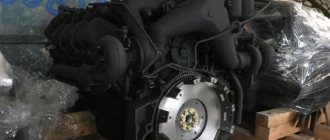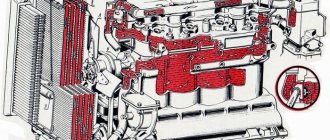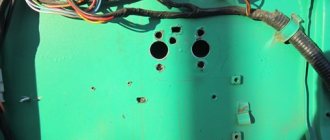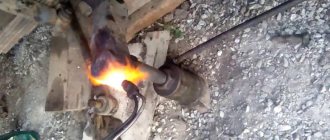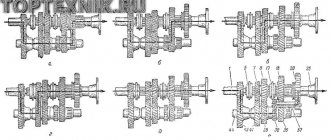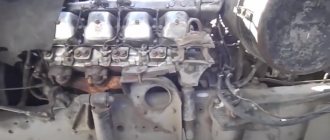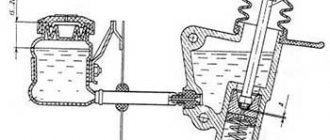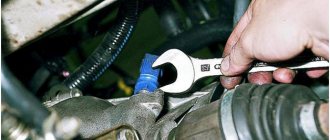The operating principle of the thermostat and instructions for replacing it on KamAZ vehicles
The KamAZ thermostat is designed to automatically maintain the optimal temperature regime of the power unit under various operating conditions. This is facilitated by the redirection of medium flows in the cooling system of the KamAZ engine. On a cold unit, antifreeze moves in a small circle: pump - cylinder block jackets - thermostat - pump. After the coolant reaches 80°C, part of the medium is redirected by the thermostat to the radiator. This circulation pattern is called a great circle.
Cooling system for Kamaz vehicles
The cooling system provides support for the desired heat regime in the Kamaz engine. The unit is liquid and has a closed, sealed housing. Main elements of the cooling system:
- radiator;
- ventilation system;
- tank with expansion;
- wiring of specialized channels;
- water-based pump;
- thermostatic systems;
- lines for the passage of coolants.
The cooling system design diagram is shown in the figure above: 1 - tank with expansion elements; 2 - pipe for steam outlet; 3 - channel for air release; 4.6 - outlet channel for liquid; 5 - connecting element; 7.9 - pump inlet; 8 - water transformer; 10 — connecting tube between the radiator and the pump; 11 - output element of the device; 12 — tube for fastening; 13 — bypass clamp; 14 — tube for passing liquid into the heating channel; 15 - oil-based heat exchange device; 16 — water-based box; 17 — connection to the compressor; 18 — clamping tube.
A full description of each element is presented on the official Kamaz website.
Where is it located and how is it arranged?
Due to the large volume of the KamAZ engine cooling system, they are equipped with 2 thermostats, which are located in one housing, located on the front wall of the right cylinder block. This arrangement is due to the fact that the coolant is first supplied by the pump to the left cylinder block, and then through the bypass pipe to the right one. Once in the thermostat box, hot antifreeze is directed either to the pump suction (warming up the engine) or to the radiator. The fan, pumping air, takes heat from the coolant. Cooled antifreeze from the lower tank enters the pump suction.
The thermostat is a simple but important device in the engine cooling system. It consists of:
- housings;
- two valves;
- rod;
- cylinder with wax;
- springs.
The principle of operation is based on increasing volume when melting solids. The latter is ceresin, which is a mixture of wax and aluminum powder. The actuators (valve) are fixed to the stem. When starting a cold engine, one of them (the main one) is in the closed position, and the other (the small circle valve) is open.
When the coolant is heated, the wax in the cylinder passes into the liquid phase. Having reached a temperature of 80°C, ceresin displaces the rod, as a result of which the main (upper) valve opens and the small circle valve (lower) closes. Part of the antifreeze enters the cooling radiator. At a coolant temperature of 93°C, the upper valve opens completely. The entire flow is directed to the radiator, because the bottom valve shuts off the liquid supply to the pump suction.
As the coolant cools, the valves begin to move in the opposite direction, and the process repeats. The parameters in the cooling system are automatically maintained.
Purpose and device
Thermostats on KamAZ are designed to regulate the temperature and antifreeze circulation process. To cool the power unit of this machine, 35 liters of antifreeze are required. Such a volume, with high pressure and circulation speed, requires large throughput. For this reason, manufacturers have equipped the cooling system with a thermostat with two valves.
Truck owners may wonder where the thermostat is located on a KamAZ. This mechanism is located at the front end of the right cylinder block. This arrangement allows for the most efficient operation of the cooling system. The thermostat consists of:
- Housings with two channels.
- 2 shut-off valves.
- Valve cover.
In turn, the shut-off valve consists of the following elements:
- Flask with ceresin installed in the center of the valve.
- Push rod.
- Return spring.
- 2 small locking bowls and 2 large ones.
The configuration is no different from thermostat shut-off valves in passenger cars; they are simply larger in size and diameter.
How to change
Before replacing the thermostat, you will have to perform related dismantling work. To change it, you need to remove the generator belt, loosen the fastening bolts and move the mechanism to the side. Before removing the hose from the radiator pipe, drain 2-3 liters of coolant, dismantle the clamps and carefully pull the corrugation off the fitting. After this, the thermostat box is removed
To replace them, the cover is dismantled. After installing functional parts, the oil seal is replaced and the box is closed. Reinstallation is carried out in reverse order.
The operating principle of the thermostat and instructions for replacing it on KamAZ vehicles: we tell you all the nuances
The system that regulates the cooling of KamAZ is a complex structure associated with the technical components of the vehicle. For the famous cars produced by the Kama Automobile Plant, a temperature of 80 to 120 degrees Celsius is recommended for the fluid. In this case, the engine temperature sometimes reaches 220 degrees. Such technical characteristics determine the mandatory maintenance of the system used.
The design and principle of operation of the thermostat
Most modern thermostats, regardless of type, have the same design. The thermostat is based on the simple principle of increasing the volume of bodies when they are heated, and a substance with a high coefficient of volumetric expansion is used as a working fluid - usually wax mixed with copper powder (and sometimes with aluminum and graphite). When heated, this mixture melts and increases in volume - this is expansion and is used to open and close the valve.
The basis of the thermostat is a frame, inside which a thermoelement and a valve (or valves) are fixed. The thermoelement is a capsule with wax placed in the valve body (this is a small cylinder), into which a rod is placed through a guide device (another cylinder or cone with a channel made in the axis), rigidly fixed in the frame. A plate (or two on different sides in a two-valve thermostat) is attached to the valve body and is held in the closed position by a return spring.
The thermostat works very simply. When the thermoelement is heated, the wax melts, increases in volume and pushes the valve body, which moves along the stem, overcomes the resistance of the return spring and opens the valve. When the thermocouple cools, the wax crystallizes again and decreases in volume, and the return spring closes the valve.
Typically, the thermostat is made in the form of a separate compact unit, which is mounted in the pipes and can be easily removed for inspection or replacement.
In conclusion, let’s say that the thermostat is a very simple device, but important for engine operation. Therefore, the thermostat must be changed immediately when a malfunction is detected (which is expressed by engine overheating) - this is the only way to ensure high-quality operation of the engine and extend its life.
Basic faults
A common malfunction of the thermostat is the valve not closing tightly. After starting the engine, antifreeze circulates in a large circle. This leads to a long time to reach the nominal temperature. In winter, the engine may not reach the required 90°C at all. By operating a car with such a breakdown, the owner reduces the engine's life every day, since prolonged warming up is contraindicated for the engine.
A valve stuck in the closed position can have more serious consequences. After reaching a temperature above the nominal temperature, the liquid continues to circulate in a small circle. If the car owner does not check whether the thermostat is working, the engine will boil. Unlike gradual excessive wear when the valve is constantly open, its closed position can lead to a major overhaul of the engine at the first emergency situation. Jamming of pistons, warping of metal parts, destruction of rubber products and other serious consequences accompany engine boiling, so if the first signs of a thermostat malfunction appear, it is necessary to diagnose it and, if necessary, replace the jammed product with a new one.
If the heat-sensitive fill material leaks, the valve may be delayed in response. If the time interval is large enough, the consequences will be similar to jamming. In some cases, coolant enters the sealed cavity, changing the temperature coefficient of expansion.
Possible faults
Any system has its weak points that need to be checked. If you diagnose a minor breakdown in time, you can avoid further major problems. The driver can visually identify most faults independently.
- Antifreeze leak. This type of malfunction is so noticeable that the driver’s main task is to look under the hood more often. The malfunction will be expressed by smudges and spots corresponding to the color of the coolant. A leak is possible due to the tank being incomplete or overflowing. The most vulnerable spot is the connection of the pipes. Leaks can also occur due to destruction (wear) of rubber hoses. Therefore, it is the pipes that are considered the weak point. To eliminate a leak, you need to carefully check whether all fixing bolts are tightened and perform a pressure test.
- Coolant overheating is a complex problem of poor operation of the entire unit. Reaching more than ninety-five degrees, the antifreeze will boil, so you need to better monitor the temperature.
- Hypothermia, similar to overheating, disrupts the integrity of a group of mechanisms. Too low a temperature prevents the engine from starting correctly. When running “cold,” the engine idles longer; some drivers call this problem “snatching air,” in other words, the system for pumping air masses inside the blocks also begins to malfunction. An important point is in what position the valve jams. If the “O” position is open, then the coolant will “walk” in a large circle through the radiator, preventing the cold engine from warming up.
- The most serious problem is coolant getting inside the oil system.
Important elements of the system
KamAZ vehicles have a cooling system reminiscent of classic versions. Moreover, each unit is important, because it is responsible for the functionality of the system and the correct movement of coolant.
Note! It should be noted that there are two thermostats. They are required for the full operation of the installed engines. Also, special blinds are installed on the radiator, and in the cold season they are closed to speed up the heating of the power unit.
where is it located, how to change it, replacement, how much does it cost
The KamAZ thermostat is designed to automatically maintain the optimal temperature regime of the power unit under various operating conditions. This is facilitated by the redirection of medium flows in the cooling system of the KamAZ engine. On a cold unit, antifreeze moves in a small circle: pump - cylinder block jackets - thermostat - pump. After the coolant reaches 80°C, part of the medium is redirected by the thermostat to the radiator. This circulation pattern is called a great circle.
Where is it located and how is it arranged?
Due to the large volume of the KamAZ engine cooling system, they are equipped with 2 thermostats, which are located in one housing, located on the front wall of the right cylinder block. This arrangement is due to the fact that the coolant is first supplied by the pump to the left cylinder block, and then through the bypass pipe to the right one. Once in the thermostat box, hot antifreeze is directed either to the pump suction (warming up the engine) or to the radiator. The fan, pumping air, takes heat from the coolant. Cooled antifreeze from the lower tank enters the pump suction.
The thermostat is a simple but important device in the engine cooling system. It consists of:
- housings;
- two valves;
- rod;
- cylinder with wax;
- springs.
The principle of operation is based on increasing volume when melting solids. The latter is ceresin, which is a mixture of wax and aluminum powder. The actuators (valve) are fixed to the stem. When starting a cold engine, one of them (the main one) is in the closed position, and the other (the small circle valve) is open.
When the coolant is heated, the wax in the cylinder passes into the liquid phase. Having reached a temperature of 80°C, ceresin displaces the rod, as a result of which the main (upper) valve opens and the small circle valve (lower) closes. Part of the antifreeze enters the cooling radiator. At a coolant temperature of 93°C, the upper valve opens completely. The entire flow is directed to the radiator, because the bottom valve shuts off the liquid supply to the pump suction.
As the coolant cools, the valves begin to move in the opposite direction, and the process repeats. The parameters in the cooling system are automatically maintained.
How to change
Before replacing the thermostat, you will have to perform related dismantling work. To change it, you need to remove the generator belt, loosen the fastening bolts and move the mechanism to the side. Before removing the hose from the radiator pipe, drain 2-3 liters of coolant, dismantle the clamps and carefully pull the corrugation off the fitting. After this, the thermostat box is removed
To replace them, the cover is dismantled. After installing functional parts, the oil seal is replaced and the box is closed. Reinstallation is carried out in reverse order.
Engine thermostat
There are several signs that will help you not to confuse a broken thermostat with other vehicle problems. Mechanics point out five facts that indicate your thermostat needs to be replaced, or engine overheating will be next.
So, a failed thermostat shows:
- quite a long time to warm up the engine until it reaches operating temperature
- very fast engine overheating
- the temperature needle of the engine drops at a speed slower than usual, and when the vehicle stops it rises
- after 3-5 minutes of warming up the engine, the lower pipe is warm - this indicates that the thermostat valve is open
- when the engine is warm, the lower pipe does not heat up, remaining cold all the time, even if the engine is overheated - all this indicates a constantly closed valve; This happens when the thermostat gets stuck.
Where is the thermostat located in KAMAZ?
Thermostat repair and installation + Installation of pipe
How to remove a radiator on a Kamaz car
thermostat check, thermostat not working, thermostat comparison
thermostat for cummins
Changing the oil in the Kamaz engine
How to check a car thermostat at home. Thermostat Ford Focus 1
Diesel thermostat YaMZ 236238240.
replacing a pump on KAMAZ 5460
How to check the thermostat.
- Where do white KAMAZ trucks come from?
- KAMAZ maximum slope
- Turbine k27 Czech Republic for KAMAZ
- Cabin without sleeping bag KAMAZ
- What batteries for KAMAZ
- KAMAZ on methane manufacturer
- Disassembly of the KAMAZ front hub
- Water pump KAMAZ 5310
- Heater valve KAMAZ 43118
- KAMAZ ECU diagnostics
- Warranty period KAMAZ 6520
- Fog lights KAMAZ 4310
- Replacing fine fuel filters on KAMAZ
- Truck crane ks55713 5k 3 on KAMAZ chassis
- KAMAZ sewer cleaning
Home » Hits » Where is the thermostat located in KAMAZ
Buy a KamAZ thermostat from the manufacturer
This mechanism is a key component in the cooling system of any car equipped with an internal combustion engine. A properly functioning thermostat extends engine life and helps reduce fuel consumption.
offers a wide range of original KamAZ spare parts: KamAZ thermostat block, 80°C thermostat, pipe (thermostat box cover), thermostat set (2 thermostats + 1 gasket), thermostat box assembly. The price for a KamAZ thermostat is finalized when placing an order. Make a purchase with convenient delivery throughout Ukraine on the company’s website.
